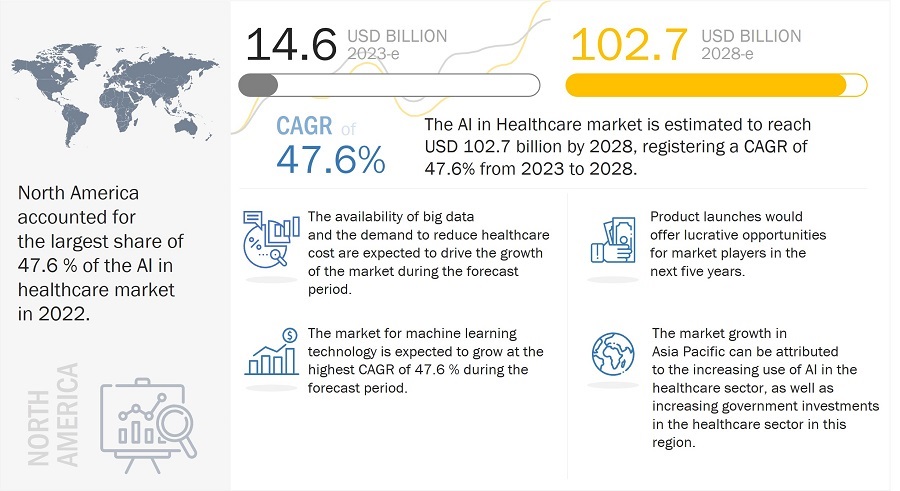According to a research report "Artificial Intelligence in Manufacturing Market by Offering (Hardware, Software, and Services), Industry, Application, Technology (Machine Learning, Natural Language Processing, Context-aware Computing, Computer Vision), & Region - Global Forecast to 2027" published by MarketsandMarkets, the global Artificial Intelligence in Manufacturing market size is projected to grow from USD 2.3 billion in 2022 to USD 16.3 billion by 2027, it is expected to grow at a CAGR of 47.9% from 2022 to 2027.
• Informational PDF Brochure :-Browse 195 market data Tables and 58 Figures spread through 270 Pages and in-depth TOC on "Artificial Intelligence in Manufacturing Market & Region - Global Forecast to 2027"
The key factors contributing to the growth of artificial intelligence in manufacturing market include improving computing power of AI chipset and increasing venture capital investments in manufacturing AI space. However, increasing venture capital investments in manufacturing AI space is hindering the growth of artificial intelligence in manufacturing market. Limited availability of skilled workforce, especially in developing countries possesses a huge challenge to the industry. However, growing focus on boosting operational efficiency of manufacturing plants is the biggest opportunity in the market space with Asia Pacific having the highest market share and CAGR for the forecast period.
Development of sophisticated hard and soft sensors to boost growth of context-aware computing segment
By using context awareness technology, a control system called Manufacturing Execution System (MES) is designed for managing and monitoring works in a factory, which is based on the dynamic and complex production process in the manufacturing plant. The context-awareness architecture establishes the dynamic interaction properties of the system more thoroughly and guides object specification and abstraction tasks in machine language. This technology provides computing environments with the ability to learn and adopt the context by sensing through different sensors and automatically provides feedback to the user. This service makes the operator attentive, responsive, and predictive. In the manufacturing plant, the production quantity varies on many uncertain factors, including internal and external factors such as random orders, sudden equipment fault, supply modification, and runtime restriction. Context-aware technology finds customized solutions and arranges the machines accordingly for the issues mentioned above. Siemens (Germany) and General Motors (US) use context awareness technology in their plants. Additionally, context-aware information distribution may offer substantial value to industries. It provides task-relevant information or services to users on a manufacturing shop floor, improving decision-making through context-driven recommendations.
Asia Pacific exhibit the highest CAGR during the forecast period
APAC is likely to be the highest contributor in terms of market size and growth rate in the overall AI in manufacturing market during the forecast period. This market in APAC is further divided into China, Japan, South Korea, India, and Rest of APAC (RoAPAC). RoAPAC includes Singapore, Malaysia, Thailand, Australia, and New Zealand. Among all the countries in APAC, China held the largest share of the AI in manufacturing market in 2021.
APAC, led by China, Japan, and South Korea, is considered the largest market for industrial robots. Industrial robots generate a huge amount of data. This data is used in deep learning algorithms to further train the robots. This would act as one of the major drivers for the AI in manufacturing market in APAC. APAC is also considered to have the most number of manufacturing plants in the world. There are a few dark plants in China, where only robots work without any human intervention. AI implementation can make robots smarter, reduce the downtime of machines, and increase productivity.
Advancement in deep learning and supervised learning manufacturing industry to drive growth of AI in manufacturing market for machine learning
Machine learning (ML) enables systems to improve their performance automatically with experience. ML helps develop a computer program/algorithm that can access data and use it to train itself without human intervention. ML is adopted to deal with large volumes of data. The time previously dedicated to analyzing charts and spreadsheets is now being utilized to seek intelligent ways to automate data analysis. ML includes various technologies, such as deep learning, supervised learning, unsupervised learning, and reinforcement learning.
Extensive use of big data in production planning to fuel market growth
Production planning is a process that combines and transforms various resources used in the production system in a manufacturing plant. The AI system executes the interrelated operational activities involved in the manufacturing processes. The deep learning-based algorithm uses many functions such as Programme Evaluation Review Technique (PERT)/Critical Path Method (CPM) to optimize the production planning under various conditions. The use of AI in production planning leads to the standardization of product and process sequence, dedicated special-purpose machines having higher production capacities and output rates, short production cycle time, perfectly balanced production lines, faster flow of materials, and easy material handling.
The key players operating in the artificial intelligence in manufacturing market NVIDIA (US), IBM (US), Intel (US), Siemens (Germany), General Electric (US), Google (US), Microsoft Corporation (US), and Micron Technology (US). The players in this market have adopted various strategies to expand their global presence and increase their market shares.
About MarketsandMarkets™
MarketsandMarkets™ provides quantified B2B research on 30,000 high growth niche opportunities/threats which will impact 70% to 80% of worldwide companies’ revenues. Currently servicing 7500 customers worldwide including 80% of global Fortune 1000 companies as clients. Almost 75,000 top officers across eight industries worldwide approach MarketsandMarkets™ for their painpoints around revenues decisions.
Contact:
Mr. Aashish Mehra
MarketsandMarkets™ INC.
630 Dundee Road
Suite 430
Northbrook, IL 60062

